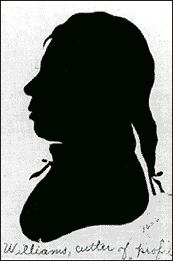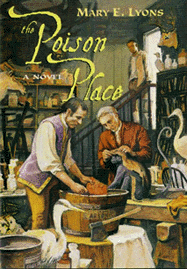|
 WHAT WAS
MOSES WILLIAMS THINKING? WHAT WAS
MOSES WILLIAMS THINKING?
 Silhouette of Moses Williams
attributed to Raphaelle Peale. Courtesy of the Library Company of Philadelphia. Silhouette of Moses Williams
attributed to Raphaelle Peale. Courtesy of the Library Company of Philadelphia.
Charles Willson Peale was one of America's first scientists and portrait
painters. Moses Williams cut silhouettes in Peale’s Museum over 200 years ago.
Now we remember him as one of the earliest African-American artists in the
United States.
Silhouettes, also called profiles, were popular in the eighteenth and
nineteenth centuries. Photography had not been invented and portrait painting
was expensive. For many people, profiles were the only affordable way to
have their picture taken.
Right-click with your mouse, choose Print, and print the
silhouette of Moses Williams. Imagine what his thoughts as Raphaelle traced his
silhouette. Was he thinking of his secret about the poison? Or
wondering if Peale would ever set him free? Maybe Moses was thinking about Peale's
new cook, Maria. Write Moses Williams's thoughts underneath the picture.
 BE
AN ARTIST WITH SCISSORS BE
AN ARTIST WITH SCISSORS
Materials:
yardstick, chair, lamp, tape, pencil, embroidery or manicure scissors, glue,
a square of white paper and a square of black paper
Preparation:
Place a straight-backed chair in an empty corner of a darkened room. Place
the chair so that it faces one wall.
Lightly tape a piece of white paper to the other wall.
Ask a friend to sit in the chair with the side of her face next to the paper.
Brace her head by resting one end of the yardstick against her forehead and
the other end against the wall. This will keep her head still while you
trace the silhouette.
Trace:
Shine the lamp on your friend's face so that it casts a shadow on the paper. Use the
pencil to trace around the shadow made by her face, hair, and neck.
Cut:
Remove the paper from the wall. Use embroidery scissors to carefully
punch a small hole in the center of the traced silhouette. From within the
traced lines, cut out the rest of the silhouette. A margin of white paper
should remain around the edges.
Mount:
Write the date and your friend's name on the bottom margin. As the
artist, you should sign your name, too. Lightly glue the hollow-cut
silhouette to black paper.
Click to see Raphaelle Peale's
"Bowl of Peaches"
Click to see Raphaelle Peale's "Still Life with Strawberries and Nuts"
Click to see Charles Willson Peale's portrait of Raphaelle Peale
as
described in The Poison Place on p. 144. |
 The Poison Place: A Novel
The Poison Place: A Novel
 Silhouette of Moses Williams
attributed to Raphaelle Peale. Courtesy of the Library Company of Philadelphia.
Silhouette of Moses Williams
attributed to Raphaelle Peale. Courtesy of the Library Company of Philadelphia.